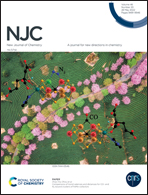Reactivity of multi-arm polyols towards isocyanates†
Abstract
In this research, the kinetics of the reaction of various polymer polyol crosslinking agents with phenyl isocyanate is reported. Pentaerythritol (PE), trimethylol propane (TMP), ethoxylated (PEEO) and propoxylated (PEPO) pentaerythritol oligomers as well as Petol PA 500-5D (a propoxylated diethylenetriamine with 5 arms) were used as crosslinking agents. These polyols were applied in high molar excess to isocyanate to obtain pseudo first-order rate dependencies. The reaction products were separated by HPLC and detected by UV absorption. It was found that trimethylol propane (kTMP = 0.0819 min−1), due to its electron donating group, was slightly more reactive than pentaerythritol (kPE = 0.0700 min−1). Moreover, ethoxylated and propoxylated derivatives were found to be less reactive than PE, which can be explained by the electron withdrawing property of the alkoxy groups. In addition, Petol PA 500-5D was determined to be the most reactive polyol, which is ascribed to the fact that it carries some catalytic properties similar to other tertiary amine catalysts. Furthermore, the reactions were also carried out in high isocyanate molar excess to polyols in order to determine how the number of reacted hydroxyl groups influences the reactivity of unreacted hydroxyl groups. The separation of the products could be achieved by HPLC for PE and TMP; however, in the case of PEEO, PEPO and Petol PA 500-5D, due to the high number of products, MALDI-TOF MS was applied. The results clearly showed that the reactivity of the unreacted OH groups significantly changed upon reaction in the case of PE and TMP, while for the polymer polyols, steric and inductive effects slightly modified the relative reactivities of the OH groups in each crosslinking agent.



 Please wait while we load your content...
Please wait while we load your content...